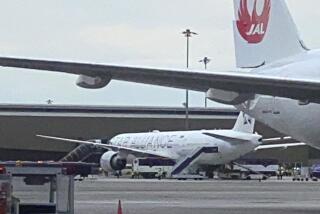Executive Travel : Airplane Seats Behind Dividers May Pose Risk
- Share via
Those seats facing the interior dividers separating classes aboard airliners may give the traveler a bit more leg room, but in some cases they might also be a more hazardous place to sit.
That’s the view of one airline injury specialist who says the walls or dividers pose a problem that airlines worldwide have been trying to address.
Head injuries suffered by people sitting behind the dividers, who were hurt during sudden stops or turbulence, are the top noncrash injury concern aboard airliners, in the view of Hamid Lankarani of the National Institute of Aviation Research at Wichita State University in Kansas.
“These walls are structures that do not give. We need to make new designs that better absorb the energy of the impact,” he said.
Reducing the number of such injuries would not be costly, Lankarani said, noting that they are not an everyday occurrence.
In 1988, the Federal Aviation Administration adopted regulations dealing with aircraft seats and surrounding structures. One spokesman for the agency said the new Boeing 777 is the only aircraft so far to reach full compliance with those standards as they relate to interior walls.
A researcher at the FAA’s Civil Aeromedical Institute in Oklahoma City, in a safety journal article, described the problem this way:
“Passengers seated in these locations are usually forward-facing with about 35 inches between the seat back and the wall. With only lap belts to restrain the occupants in the event of a crash, the upper torso of each person will flail forward quickly during impact.
“If the design of the wall does not include a means to prevent head contact or to absorb the energy of the impact, an occupant faces the potential for serious trauma to the skull and brain.”
The FAA researcher added that turning the first row of seats around to face the opposite direction or moving them farther from the dividers are possible solutions but that both would involve a loss of space or a redesign of seats.
The FAA has looked at energy-absorbing wall materials, seats that shift and push the passengers up instead of forward on impact and at air bags as ways of dealing with the problem.
Lankarani has another concern: the placing of phones on seat backs. The hard materials in the phones present a risk of head injury if passengers are suddenly pitched forward, he said.
In newer planes and in some first-class sections, the phone has been moved to the armrest, but the industry is looking at seat backs for video screen placement, so the problem may persist.
Lankarani said his best advice to passengers is to keep their seat belts fastened at all times. He also said passengers in both smaller corporate-type jets and in the lounge areas of big planes where side-facing seats have been installed should be aware that they could be bounced around during turbulence in a different way than in a forward-facing seat.


